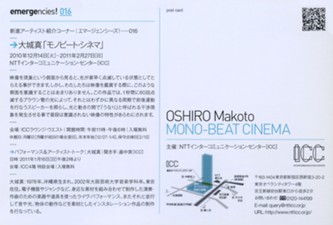A sine wave is generated by a loudspeaker set in front of a light emitting cathode-ray tube TV monitor. The frequency outputted by the loudspeaker is perceived as sound, but the vibration of the loudspeaker can also be perceived as a visible phenomenon. At the same time, when the screen image of the TV monitor is observed from the point of view of phenomena, it can be explained as a light that is flickering rapidly. In this piece, the flicker of the TV monitor interferes with the vibration of the loudspeaker, and affects the visual appearance of the loudspeaker.
Sine waves can easily be interfered when different frequencies are combined, and this interference can cause another frequency originally not existing, to appear within the sound waves. This is an occurrence of a heterodyne called a “beat.” It appears as a frequency of the difference between the two interfering frequencies, but in this piece, an aspect that we do not notice when we watch video images or movies becomes obvious not only to our ears, but also to our eyes. The light of the cathode-ray tube flickering 60 times per second shines a loudspeaker that vibrates in a slightly different frequency from that, causing a “beat” to occur between the light and movement, and lets us become aware of a characteristic of video images that is usually not noticed.


